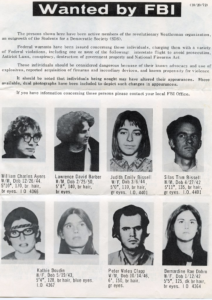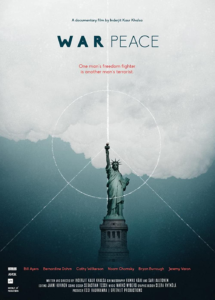The documentary WarPeace attempts to cover the history of the radical group Weather Underground and connect it with movements today. Anchoring the film is the question: “how can we make a change if peaceful demonstration is not effective and violence only brings more violence?” The film scratches the surface on the history of one of the most controversial sects of the US anti-war movement. I wish that the creators had increased the documentary’s length from 60 minutes to discuss The Weather Underground more thoroughly and to strengthen their connection to their framing question and to movements today.

The strongest part of this documentary is the interviews with Weather Underground members Bernardine Dorhn, Cathy Wilkerson, and Bill Ayers. All three lived underground for many years, and Cathy was in the famous townhouse in New York City during the bomb blast and later served time in prison. They all spoke about the despair at the apparent lack of impact of nonviolent protest in ending the war in Vietnam that led them to more seek other means to fight imperialism. They also discussed their solidarity with the Black Panther Party, and how the assassination of Fred Hampton was a moment of radicalization. The general takeaway I gathered from these three radicals is that they do regret that people got hurt—especially that they were unable to protect their comrades—but that they do not regret taking a stand against US Imperialism abroad and injustice at home and doing so in a radical way.
The documentary discusses the townhouse explosion, where three members were killed due to early detonation of a bomb meant for a military dance event and what the group may be most known for. According to those interviewed, it was a violent outlier event for the group, in that the bombs were planned for human targets. For the Weathermen who went underground after the townhouse explosion, it was a catalyst to reaffirm commitment to the value of human life and choosing actions that would not put people at risk. They still used bombs but did so when buildings would be empty. Therefore, the historic framing as violent revolutionaries does not capture the nuance of this group. While this documentary briefly speaks to the general commitment to not cause physical harm, it does not actively dispute the media narrative of Weather Underground being one of the greatest domestic terrorist groups in US history.

If the filmmakers wanted to tie the history of Weather Underground more effectively to the tensions and challenges of today’s movements, they could have asked activists how they are currently grappling with the question raised at the beginning of the documentary: “how can we make a change if peaceful demonstration is not effective and violence only brings more violence?”. Overall, I think this film will increase audience interest in this maligned movement. It provides many jumping off points for discussions for courses about social movements and in groups of activists. But, if looking for an exhaustive look at Weather Underground, look elsewhere.